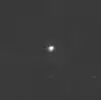(145451) 2005 RM43
(145451) 2005 RM43, provisionally known as 2005 RM43, is a trans-Neptunian object that resides in the scattered disc region beyond the Kuiper belt. It was discovered on 9 September 2005, by American astronomers Andrew Becker, Andrew Puckett and Jeremy Kubica at Apache Point Observatory in Sunspot, New Mexico. It measures between approximately 500 and 650 kilometers in diameter.[2][8]
 Hubble Space Telescope image of 2005 RN43 taken in 2008 | |
| Discovery[1] | |
|---|---|
| Discovered by | A. C. Becker A. W. Puckett J. M. Kubica |
| Discovery site | Apache Point Obs. |
| Discovery date | 9 September 2005 |
| Designations | |
| (145451) 2005 RM43 | |
| SDO[2] | |
| Orbital characteristics[1] | |
| Epoch 27 April 2019 (JD 2458600.5) | |
| Uncertainty parameter 2 | |
| Observation arc | 14983 days (41.02 yr) |
| Earliest precovery date | 17 November 1976 |
| Aphelion | 144.140 AU (21.5630 Tm) |
| Perihelion | 35.079 AU (5.2477 Tm) |
| 89.610 AU (13.4055 Tm) | |
| Eccentricity | 0.60854 |
| 848.28 yr (309834 d) | |
| 6.19° | |
| 0° 0m 4.183s / day | |
| Inclination | 28.819° |
| 84.61° | |
| 318.10° | |
| Physical characteristics | |
Mean diameter | ≈644 km (derived from occultation; 455 and 460 km measured)[3] 524+96 −103 km[4] 458 km (lower limit)[5] |
Mean density | >0.56 g/cm3[2] |
| 6.71 h (0.280 d) | |
| 0.102[4] | |
| V–R=0.33±0.02 (neutral)[4] B0−V0=0.590[6] B-R=0.99[2] | |
| 20.4[7] | |
| 4.52±0.01[4] 4.4[1] · 4.8[8] | |
Description

2005 RM43 is considered likely to be a dwarf planet by both Brown and Tancredi.[8][10] Based on an absolute magnitude of 4.4, the body's diameter could be anywhere in the range of 350 to 800 kilometres (km), depending on its albedo, the surface reflectivity of the object.[11] Johnston's Archive gives an estimate of 584 km, based on an assumed albedo of 0.09.[2] Brown estimates a diameter of 524 km, based on an absolute magnitude of 4.8 and an assumed albedo of 0.08. A stellar occultation by 2005 RM43 in December 2018 gave a minimum diameter of 458 km.[5]
In 2018, two stellar occultations by 2005 RM43 were observed on 3 February and 24 December.[3] Observations of the February occultation yielded a single chord length of 456 km (283 mi).[12] Observations of the December occultation yielded two positive chords, which suggest an approximate diameter of 644 km (400 mi) for 2005 RM43.[13]
2005 RM43 has been observed 303 times over 17 oppositions, with precovery images dating back to 1976.[1][14] The orbit is well determined with an uncertainty parameter of 2.[1]
References
- "JPL Small-Body Database Browser: 145451 (2005 RM43)" (2017-11-25 last obs). Retrieved 2 February 2019.
- Wm. Robert Johnston. "List of Known Trans-Neptunian Objects". Johnston's Archive. Archived from the original on 2 February 2019. Retrieved 2 February 2019.
- "TNO Results". ERC Lucky Star Project. Laboratoire d'Etudes Spatiales et d'Instrumentation en Astrophysique (LESIA). Retrieved 13 July 2020.
- Farkas-Takács, A.; Kiss, Cs.; Vilenius, E.; Marton, G.; Müller, T. G.; Mommert, M.; et al. (28 February 2020). "TNOs are Cool! A Survey of the transneptunian Region XV. Physical characteristics of 23 resonant transneptunian and scattered disk objects". Astronomy & Astrophysics. A23: 638. arXiv:2002.12712. Bibcode:2020A&A...638A..23F. doi:10.1051/0004-6361/201936183. S2CID 216193564.
- Frappa, E. "2018 European Asteroidal Occultation Results". euraster.net. Retrieved 2 February 2019.
- David L. Rabinowitz; Bradley E. Schaefer; Martha W. Schaefer; Suzanne W. Tourtellotte (2008). "The Youthful Appearance of the 2003 EL61 Collisional Family". The Astronomical Journal. 136 (4): 1502–1509. arXiv:0804.2864. Bibcode:2008AJ....136.1502R. doi:10.1088/0004-6256/136/4/1502. S2CID 117167835.
- AstDyS. "(145451) 2005RM43 – Observation prediction". Department of Mathematics, University of Pisa. Retrieved 2 February 2019.
- Michael E. Brown. "How many dwarf planets are there in the outer solar system? (updates daily)". California Institute of Technology. Archived from the original on 2 February 2019. Retrieved 2 February 2019.
- Lowe, Andrew. "(145451) 2005 RM43 Precovery Images". andrew-lowe.ca.
- Tancredi, G. (2010). "Physical and dynamical characteristics of icy "dwarf planets" (plutoids)". Icy Bodies of the Solar System: Proceedings IAU Symposium No. 263, 2009. 263: 173. Bibcode:2010IAUS..263..173T. doi:10.1017/S1743921310001717.
- Bruton, D. "Conversion of Absolute Magnitude to Diameter for Minor Planets". Stephen F. Austin State University.
- "Occultation by 2005 RM43 in 03 02 2018" (PDF). ERC Lucky Star Project. Laboratoire d'Etudes Spatiales et d'Instrumentation en Astrophysique (LESIA). 3 February 2018. Retrieved 13 July 2020.
- "Occultation by 2005 RM43 in 23 DEC 2018" (PDF). ERC Lucky Star Project. Laboratoire d'Etudes Spatiales et d'Instrumentation en Astrophysique (LESIA). 24 December 2018. Retrieved 13 July 2020.
- "(145451) = 2005 RM43". Minor Planet Center. Retrieved 2 February 2019.
_(cropped).jpg.webp)
